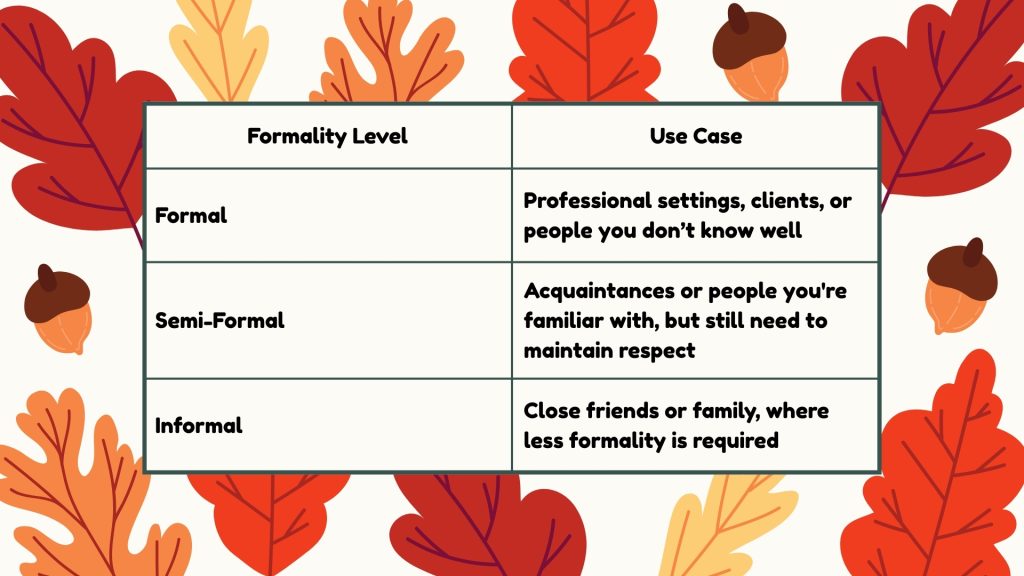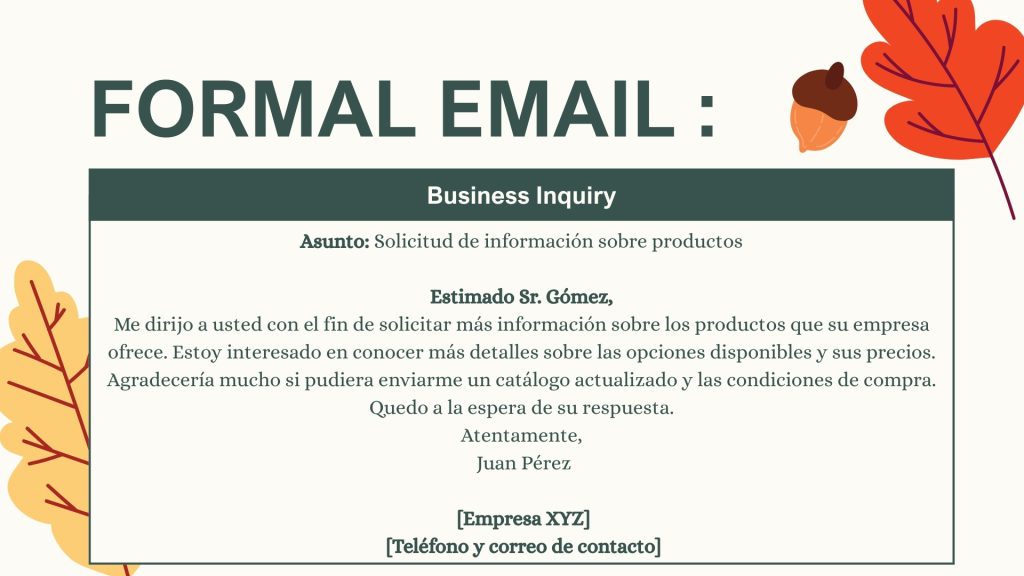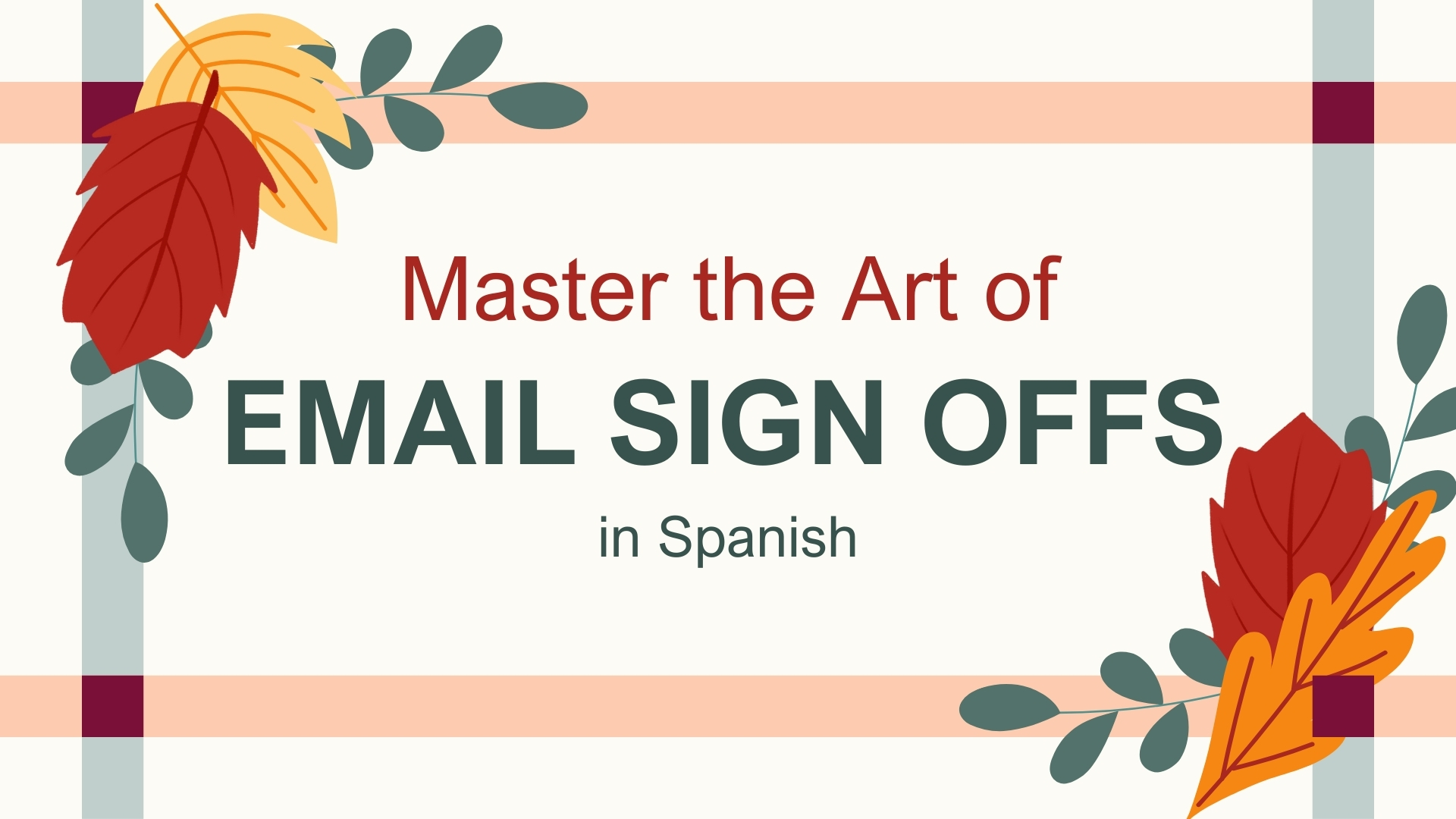Understanding how to end emails in Spanish is key for keeping things professional. You can go formal with choices like ‘Atentamente’ or ‘Cordialmente’, or keep it casual with ‘Saludos’ or ‘Un saludo’.
These sign-offs are not just about wrapping up your message; they also hint at how you see your relationship with the email’s recipient. As we all get more connected globally, knowing these little differences matters more and more.
Think about this: what does it mean when you choose one sign-off over another, depending on who you’re emailing?
Levels of Formality in Spanish
In Spanish, how you talk or write often changes depending on who you’re speaking to and the situation.

| Formality Level | Use Case |
|---|---|
| Formal | Professional settings, clients, or people you don’t know well |
| Semi-Formal | Acquaintances or people you’re familiar with, but still need to maintain respect |
| Informal | Close friends or family, where less formality is required |
From simple to tricky, our Spanish riddles offer a fun way to test your knowledge.
Email Sign-Offs in Spanish
When you end an email in Spanish, picking the right sign-off really matters. It shows respect and sets the tone for your relationship.
| Formality Level | Sign-Off (Spanish) | Meaning (English) |
|---|---|---|
| Formal | Atentamente | Sincerely |
| Formal | Cordialmente | Cordially |
| Formal | Le saluda atentamente | Yours sincerely |
| Semi-Formal | Saludos cordiales | Best regards |
| Semi-Formal | Un saludo | Regards |
| Informal | Abrazos | Hugs |
| Informal | Besos | Kisses |
| Informal | Nos vemos | See you |
Email Greetings in Spanish
When you’re writing emails in Spanish, it’s crucial to pick the right greeting. Starting an email with ‘Estimado’ (or ‘Estimada’ for women) shows respect, and is a good choice for formal situations.
| Formality Level | Greeting (Spanish) | Meaning (English) |
|---|---|---|
| Formal | Estimado/a [Name] | Dear [Name] |
| Formal | Muy señor/a mío/a | Dear Sir/Madam |
| Semi-Formal | Hola [Name] | Hello [Name] |
| Semi-Formal | Buenas tardes | Good afternoon |
| Informal | Hola [Name] | Hey [Name] |
| Informal | Qué tal | How’s it going? |
How to write a formal or business email
Writing a formal or business email in Spanish requires you to be clear and polite from start to finish.
- Start with a formal greeting: Use “Estimado/a” or “Muy señor/a mío/a” for respectful introductions.
- Be clear and concise: Avoid slang, keep your language simple and to the point.
- Use polite phrases: Incorporate respectful expressions like “Le agradezco mucho” (I greatly appreciate).
- Structure the email professionally: Organize your thoughts clearly with an introduction, body, and conclusion.
- Close with a formal sign-off: End with “Atentamente” or “Cordialmente” for a professional conclusion.
- Proofread: Always check for spelling, grammar, and tone before sending.
Mastering Spanish verb endings is easier than you think—start with the regular forms.
Example Emails in Spanish
To really get a handle on writing emails in Spanish, it helps to look closely at some examples. We’ll start with a formal email that uses professional language and follows etiquette. This will show you how to keep things proper when the situation calls for it.
Then we’ll switch gears and check out an informal email. This one will be more laid-back, using everyday language and a friendly tone. By exploring these two types, you’ll see exactly when and how to adjust your writing depending on who you’re talking to.
Formal Email in Spanish – Example 1

| Category | Formal Email (Spanish) | Meaning (English) |
|---|---|---|
| Greeting | Estimado Sr. Pérez, | Dear Mr. Pérez, |
| Subject | Solicitud de Información | Request for Information |
| Opening | Espero que este mensaje le encuentre bien. | I hope this message finds you well. |
| Body | Me gustaría obtener más detalles sobre sus productos. | I would like to get more details about your products. |
| Closing | Quedo a la espera de su respuesta. | I look forward to your response. |
| Sign-Off | Atentamente, | Sincerely, |
Informal Email in Spanish – Example 2

| Category | Informal Email (Spanish) | Meaning (English) |
|---|---|---|
| Greeting | ¡Hola Marta! | Hey Marta! |
| Subject | Plan para este fin de semana | Plan for this weekend |
| Opening | ¿Qué tal todo? | How’s everything going? |
| Body | Este fin de semana estamos planeando salir, ¿te gustaría unirte? | This weekend we are planning to go out, would you like to join? |
| Closing | Avísame si te interesa. | Let me know if you’re interested. |
| Sign-Off | Un abrazo, | Hugs, |
Conclusion
In conclusion, choosing the right sign-off in a Spanish email is crucial. It’s not just about personal taste.
Understanding these differences is key. It helps you communicate clearly and show the right amount of respect or friendliness, depending on who you’re talking to.
Don’t miss out—visit Lingua Viva for the latest updates.
Carolina is a charming and lively member of Lingua Viva with 11+ years of teaching experience. She loves to teach students appropriate ways to communicate effectively in Spanish without the fear of making mistakes. She holds a professional teaching license and has a graduate degree with emphasis in Foreign Language.











